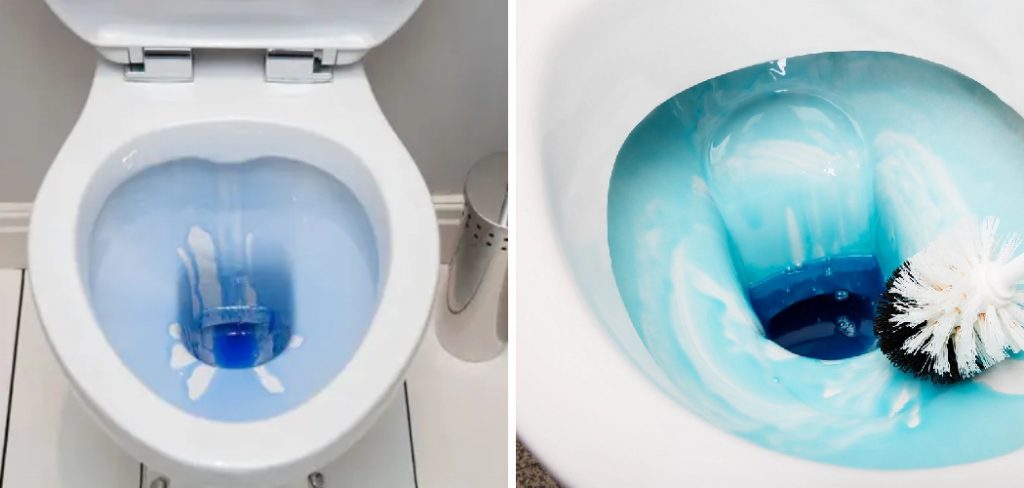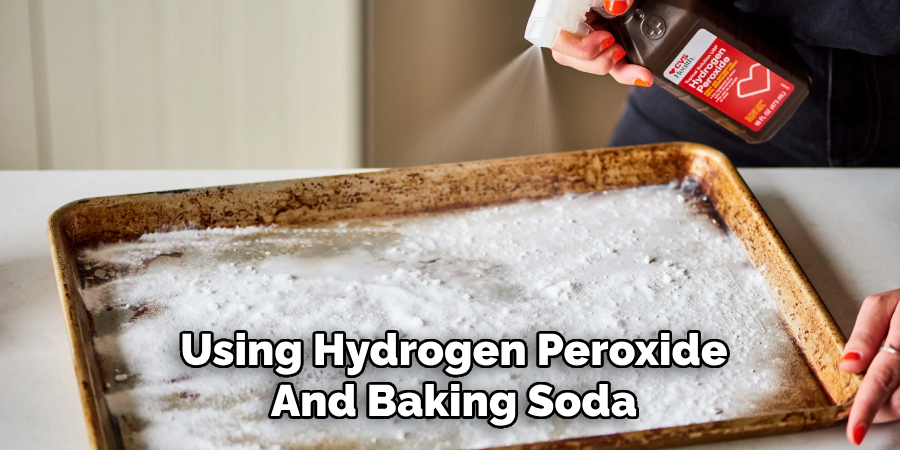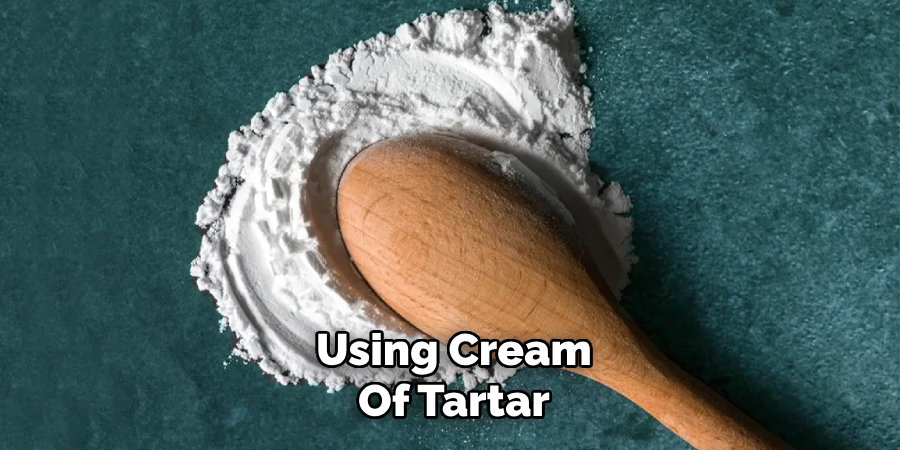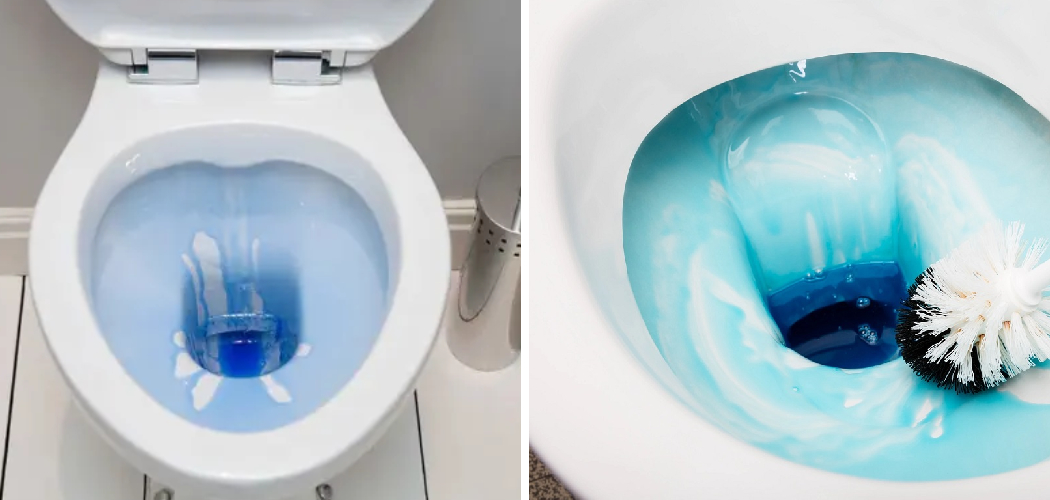Blue stains on a toilet seat can be an unsightly nuisance, often caused by mineral deposits, cleaning products, or prolonged contact with certain materials. Not only do these stains detract from the overall cleanliness of your bathroom, but they can also indicate issues with water quality or improper cleaning techniques.

In this guide, we will explore effective methods for how to remove blue stains from toilet seat, ensuring your toilet seat remains pristine and hygienic. Whether you prefer natural solutions or commercial cleaning products, there’s a method that can restore your toilet to its original condition.
Common Issues of Blue Stains on Toilet Seats
Blue stains on toilet seats are a common problem that many homeowners encounter. These stains are frequently linked to the use of certain toilet bowl cleaners that contain dyes, which can transfer to the seat during cleaning. Additionally, minerals in hard water can contribute to the formation of blue or greenish deposits when they accumulate over time.
Another factor is the prolonged contact with plastic or dyed materials, which can lead to unwanted discolouration. Identifying the source of these stains is crucial for effective removal and prevention, as it not only helps in maintaining the appearance of your bathroom but also ensures that hygiene standards are met.
Understanding the Causes of Blue Stains
Understanding the causes of blue stains on toilet seats is essential for effective prevention and removal. One of the primary culprits is the use of toilet bowl cleaners featuring artificial dyes. These products can leave residue on the seat, especially if they are not rinsed away properly. Hard water is another significant contributor; the minerals present, such as copper and manganese, can create blue or greenish stains when water evaporates, leaving deposits behind.

Furthermore, if toilet seats come into prolonged contact with dyed materials, like certain fabrics or cleaning pads, they may absorb the colours, resulting in discolouration. By identifying these causes, homeowners can adopt practices that not only eliminate existing stains but also prevent their recurrence.
10 Methods How to Remove Blue Stains from Toilet Seat
1. Using Baking Soda and Vinegar
One of the most reliable and eco-friendly methods to remove blue stains from a toilet seat is using a combination of baking soda and vinegar. The mild abrasiveness of baking soda helps lift stains, while the acidity of vinegar breaks down mineral deposits.
To use this method, start by sprinkling baking soda directly onto the stained areas of the toilet seat. Then, spray white vinegar over the baking soda, which will cause a fizzy reaction. Let this mixture sit for about 10-15 minutes. Once the bubbling subsides, scrub the stained areas using a soft sponge or cloth. The combination of baking soda and vinegar should help dissolve the blue stains without damaging the surface of the toilet seat. Rinse the seat with warm water and wipe it dry to reveal a clean, stain-free surface.
2. Using Lemon Juice and Borax
Lemon juice is a natural bleaching agent, while borax is an effective cleaner that helps remove stubborn stains, including blue discoloration on toilet seats. When combined, they create a powerful cleaning solution.
To remove the stains, mix equal parts lemon juice and borax into a paste. Apply this paste to the stained areas of the toilet seat, making sure to cover the entire surface evenly. Let it sit for about 20-30 minutes to allow the lemon juice’s acidity to break down the stain. Afterward, scrub the seat with a soft sponge and rinse thoroughly. The lemon juice will not only help remove the stains but also leave a fresh, citrusy scent behind.
3. Using Hydrogen Peroxide and Baking Soda
Hydrogen peroxide is a mild bleach that works effectively on blue stains caused by dye transfers or hard water. When paired with baking soda, it creates a paste that can lift even tough discolorations.

To use this method, create a paste by mixing 1/4 cup of hydrogen peroxide with enough baking soda to form a thick consistency. Apply the paste to the blue stains and let it sit for 20 minutes. Scrub the toilet seat gently using a soft sponge or cloth, focusing on the stained areas. After scrubbing, rinse the seat thoroughly with water and dry it with a clean towel. This method is particularly effective for older, set-in stains.
4. Using Bleach
For more severe blue stains, regular household bleach can be an effective solution. Bleach is a powerful cleaning agent that breaks down stains at the molecular level, but it should be used with caution, as it can be harsh on surfaces.
Before applying bleach, wear gloves and ensure the area is well-ventilated. Mix a solution of one part bleach to ten parts water. Dip a sponge or cloth into the bleach solution and apply it to the stained areas of the toilet seat. Let the bleach sit for about 5-10 minutes, but don’t leave it on for too long as it may cause damage to the seat’s finish. Afterward, scrub the area lightly, rinse thoroughly with water, and wipe the seat dry.
5. Using Magic Eraser
Magic Erasers are melamine foam cleaning pads that can lift a variety of tough stains, including blue marks on toilet seats. They are effective on most surfaces and work without the need for harsh chemicals.
To use a Magic Eraser, dampen it with a little water and gently rub it over the blue stains on the toilet seat. The abrasive texture of the Magic Eraser will help lift the stain without scratching the seat’s surface. Once the stains are gone, wipe the seat with a damp cloth to remove any residue and dry it with a clean towel. This method is quick and requires minimal effort.
6. Using Denture Tablets
Denture cleaning tablets are designed to remove tough stains from dentures, but they can also be used to clean blue stains from a toilet seat. Their effervescent action helps lift and dissolve stains effectively.
To use denture tablets for stain removal, dissolve one or two tablets in a bowl of warm water. Soak a sponge or cloth in the solution and apply it to the stained areas of the toilet seat. Let it sit for about 15-20 minutes. After soaking, scrub the seat gently and then rinse with water. Denture tablets are a convenient and non-abrasive option for removing discoloration from toilet seats.

7. Using White Toothpaste
White, non-gel toothpaste contains mild abrasives that can help remove blue stains without damaging the toilet seat. This method is especially useful for lighter stains or stains caused by dye transfers.
Apply a small amount of white toothpaste directly onto the blue stains. Use a soft cloth or sponge to scrub the stained areas in a circular motion. After scrubbing, let the toothpaste sit for a few minutes to allow its cleaning agents to work. Rinse the seat thoroughly with warm water and dry it with a clean cloth.
8. Using Vinegar and Salt
Vinegar’s acidity, combined with the slight abrasiveness of salt, can effectively break down blue stains caused by hard water or mineral buildup. This method is gentle on surfaces and works well on plastic or painted toilet seats.
Mix equal parts white vinegar and salt into a paste. Apply the mixture to the stained areas and let it sit for 10-15 minutes. Use a sponge or cloth to scrub the seat gently, focusing on the stains. The salt provides just enough grit to remove the stain without scratching the seat. Rinse with water and dry the seat thoroughly to reveal a cleaner surface.
9. Using Isopropyl Alcohol (Rubbing Alcohol)
Isopropyl alcohol is a powerful solvent that can dissolve blue dye stains from a toilet seat. It works especially well on stains caused by cleaning products, hair dye, or clothing.
To use this method, dampen a cotton ball or cloth with rubbing alcohol and rub it directly onto the blue stains. Allow the alcohol to sit on the stained surface for a few minutes before scrubbing with a soft cloth. The alcohol will dissolve the stain without damaging the toilet seat. After the stain is removed, rinse the seat with water and dry it with a clean towel.
10. Using Cream of Tartar and Hydrogen Peroxide
Cream of tartar is a mild acid that, when combined with hydrogen peroxide, creates a potent cleaning paste capable of removing tough stains from toilet seats.

To use this method, mix cream of tartar with hydrogen peroxide to form a paste. Apply the paste to the blue stains on the toilet seat and let it sit for about 15 minutes. Scrub the area gently with a sponge or soft brush, then rinse thoroughly with water.
Conclusion
Blue stains on toilet seats can be caused by a variety of factors, including mineral deposits, dye transfers, and hard water. With the right cleaning methods, these stains can be removed effectively without damaging the surface of your toilet seat. From eco-friendly solutions like vinegar and baking soda to more powerful agents like bleach and hydrogen peroxide, there is a range of options to suit different cleaning needs. Thanks for reading, and we hope this has given you some inspiration on how to remove blue stains from toilet seat!

